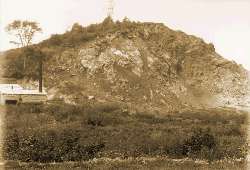Stark's Knob facts for kids
Stark's Knob is a cool rock formation in Schuylerville, New York, United States. It's made of a special type of rock called basaltic pillow lava. This rock formed a very long time ago, about 460 to 440 million years ago. It happened in shallow ocean water. People sometimes think it's a volcano, but it's not. It got its name from General John Stark. He was an important leader during the American Revolution.
What is Stark's Knob Made Of?
Stark's Knob formed when the Earth's plates moved. This happened during an event called the Taconic orogeny. An "orogeny" is a fancy word for mountain building. Back then, the Iapetus Ocean was getting smaller. This pushed ocean dirt and rocks onto the coast of North America.
This pushing also brought in a chain of islands. These islands might have looked like the Japanese islands today. All this pressure made hot, melted rock, called magma, burst out. It erupted from cracks on the ocean floor. The magma flowed out and cooled quickly in the water. This formed the "pillow lava" that makes up Stark's Knob. It looks like stacked pillows!
Scientists found tiny snail fossils in the rocks here. These snails lived in shallow water. This tells us that the lava formed in a shallow sea. This happened during the Middle Ordovician age. Over a long time, the rocks were pushed up out of the water. They also tilted towards the west. The pushing also moved Stark's Knob to where it is today. It's now just west of the Hudson River.
Stark's Knob in History
The American Revolution
Stark's Knob played an important role in the American Revolutionary War. This was during the Saratoga campaign. American forces were led by General John Stark. They used the knob to their advantage.
The American soldiers set up between the knob and the nearby Hudson River. This blocked the escape route for the British army. The British were led by General John Burgoyne. They were in Schuylerville, just south of the knob.
Stories differ about what exactly happened. But it's likely that Stark's forces placed cannons at the base of the knob. This blocked the only way out for the British. The knob is named after General Stark because of his actions there.
Modern Times
In 1916, the land for Stark's Knob was given to New York State. This helped stop people from digging up the rock. They wanted to use it to build roads. For many years, the site was not well looked after. There were even ideas to sell the land.
But then, the state decided to protect it. They wanted to stop damage and keep the trails safe. In 2005, Stark's Knob became part of the Hudson Crossing Park plan. This park is a special area around Champlain Canal Lock 5 Island.


